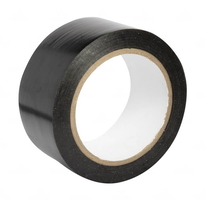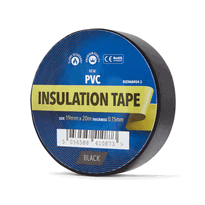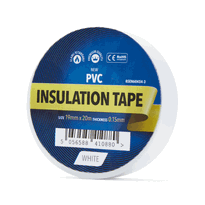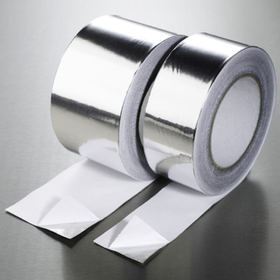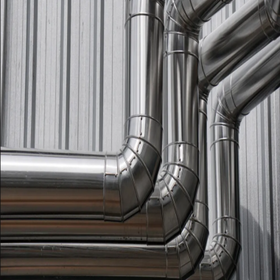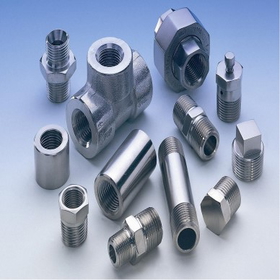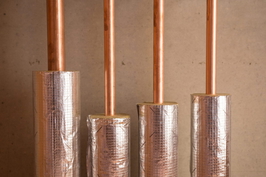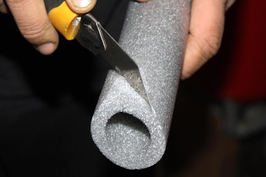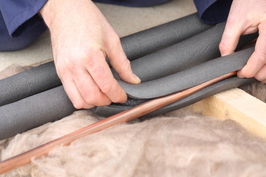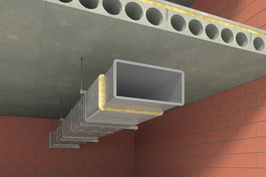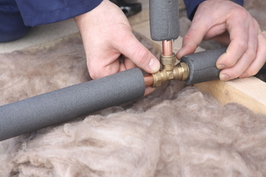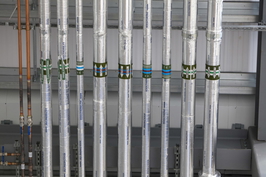Similar Categories
Understanding the Composition and Material Features of PVC Barrier Tape
PVC barrier tape is made primarily from polyvinyl chloride (PVC) resin, which imparts its core properties. This material creates a tape that's flexible, durable, and suitable for various tasks. To enhance its performance, manufacturers incorporate components such as plasticisers, stabilisers, fillers, and lubricants. Plasticisers increase flexibility, while stabilisers improve stability. Fillers augment strength and assist the tape in withstanding heat. Most PVC tapes utilise a natural rubber adhesive, ensuring a strong, airtight bond on different surfaces. The tape's features include high tensile strength, moisture resistance, and transparency, allowing visibility through the tape. It also adheres well to a variety of materials, including metals and plastics. The composition of PVC barrier tape enables it to withstand environmental conditions like UV exposure and temperature fluctuations. These material qualities make PVC barrier tapes versatile and reliable for numerous applications, providing a sense of security and dependability.
Key Applications in Construction, Roofing, and Electrical Industries
PVC barrier tape plays a vital role in the construction, roofing, and electrical industries in the UK by providing clear markers and protective barriers. It helps to separate materials, warn of hazards, and organise tools, making work sites safer and more efficient. Its versatility ensures that safety and clarity are maintained across various tasks and environments. Additionally, PVC tape’s moisture resistance makes it suitable for outdoor use where weather conditions can be unpredictable.
Construction Material Separation
In construction sites, proper organisation and safety are essential for completing projects efficiently. PVC barrier tapes play a vital role in the separation of construction materials, helping workers distinguish between different materials and prevent mix-ups. They also serve to clearly mark hazardous zones, reducing accidents and promoting safety. Using these tapes ensures that building components remain separated, avoiding damage or contamination. This organisation not only saves time but also minimises waste and additional costs. PVC caution tapes are known for their superior durability, enabling them to withstand harsh environmental conditions such as moisture, sunlight, and abrasion. Below is a quick overview:
| Purpose | Example |
|---|---|
| Material separation | Marking different construction zones |
| Safety zone demarcation | Indicating hazardous areas |
| Preventing contamination | Separating different material types |
| Improving organisation | Managing tools and supplies |
| Cost efficiency | Reducing waste and delays |
PVC tapes are trusted in construction for their visibility and durability, making them essential for efficient, safe worksites.
Roofing & Cladding Barriers
Roofing and cladding barriers are essential components in modern construction within the UK, providing protection and enhancing system performance. They prevent corrosion between different metals, such as aluminium on galvanised steel, by isolating dissimilar materials.
Their durable PVC construction resists abrasion during installation and environmental exposure, ensuring long-lasting performance. These barriers also act as waterproof layers, reducing the risks of moisture-related corrosion, and serve as secondary thermal insulators, thereby enhancing energy efficiency.
They seamlessly integrate with roofing membranes such as PVC or KEE, supporting waterproofing systems effectively. Furthermore, they offer protection against adverse weather conditions, UV degradation, and chemical exposure. PVC Barrier Tape is flame-retardant which adds an extra layer of safety during installation and in use, especially in electrical environments.
These barriers are particularly vital in coastal or chemical environments, where metal protection is critical. Proper installation, which includes surface preparation and precise alignment, guarantees maximum effectiveness, making them a reliable component of modern roofing and cladding solutions in the UK.
Electrical Insulation & Safety
Electrical insulation and safety are paramount concerns across the construction, electrical, and roofing industries in the UK, where the proper protection of wiring and components helps prevent accidents and system failures. PVC tapes serve multiple purposes, including wrapping wires for insulation, aiding phase identification with colour coding, and protecting against moisture and corrosion. They also assist with heat retention and temporary repairs.
| Application | Safety Feature | Industry Benefit |
|---|---|---|
| Wire Insulation | Flame-resistant | Prevents fires and short circuits |
| Phase Identification | Colour-coding | Improves safety and organisation |
| Environmental Protection | Moisture resistance | Ensures long-lasting electrical systems |
Comparing PVC Barrier Tape With Other Types of Barrier and Safety Tapes
PVC barrier tape differs from other types of safety tapes primarily in its material composition, with alternatives such as PET providing enhanced durability and chemical resistance. Its applications are best suited for short-term indoor use, whereas tapes like PET are more appropriate for long-term outdoor projects. PVC barrier tape is typically more affordable and easier to handle, making it ideal for quick setups. Visual features and regulations also differ, making it essential to select the right tape for specific safety and compliance requirements in the UK.
Material Composition Differences
Understanding the material composition of barrier tapes is essential for selecting the right product to meet specific safety and protection needs.
PVC barrier tape primarily consists of polyvinyl chloride resin combined with plasticisers, stabilisers, and rubber-based adhesives, which provide it with flexibility and strength.
In contrast, polyethylene tapes are made from low or medium-density polyethylene that lacks plasticisers and incorporates acrylic adhesives.
Polypropylene tapes utilise polypropylene backing with acrylic or rubber adhesives, offering improved water and UV resistance, although they may be less flexible.
PVC contains plasticisers such as phthalates for enhanced flexibility, whereas PE and PP do not.
Additionally, PVC includes stabilisers and lubricants that are absent in PE and PP tapes.
These compositional differences affect the tapes' flexibility, durability, and resistance to environmental factors, thereby assisting users in selecting the best option for their specific requirements.
In addition, the presence of colorants and additives can further influence the tapes' properties, such as visibility and chemical resistance, tailoring them to particular applications.
Application Suitability Variations
When selecting barrier and safety tapes, it's crucial to consider their specific application suitability, as different types excel in various environments and uses.
PVC barrier tape offers high durability and strength, making it ideal for heavy-duty applications such as construction sites or industrial maintenance. Its resistance to UV rays and weather conditions allows for outdoor use, while its flexibility enables it to adhere securely to irregular surfaces.
Although not primarily designed for electrical insulation, PVC does provide some insulating properties. Compared to other tapes like BOPP, PVC is more resistant to tearing and impacts, making it suitable for challenging environments.
Its vivid warning colours enhance safety visibility, and its long-term stability ensures it remains effective over time, highlighting its value in safety marking and hazard prevention.
Visual and Regulatory Features
Different barrier and safety tapes provide various visual and regulatory features that help communicate hazards effectively.
PVC barrier tapes are highly visible, with bright colours like yellow and black, which stand out in different lighting conditions. They often include patterns such as "Caution" to enhance visual alerts and may incorporate reflective materials for low-light visibility. These tapes also meet safety standards, avoiding harmful substances like lead and sometimes being flame-retardant, to ensure safety in hazardous environments. Design elements such as warning messages and symbols make safety instructions clear and easy to understand across different sites. Additionally, PVC tapes are resistant to moisture and abrasion, maintaining their appearance and message over time. These features make PVC barrier tape a reliable choice for effective hazard communication. Manufactured to meet industry safety standards, ensuring their effectiveness in various safety applications.
Safety Attributes and Regulatory Standards for PVC Barrier Tape
PVC barrier tapes play a vital role in promoting safety by clearly marking hazardous areas and helping workers and visitors recognise potential dangers quickly. They are designed to meet important safety standards, guaranteeing their effectiveness in emergency and everyday situations. These standards include: 1. ANSI Z535.5-2022, which specifies high-contrast colours for visibility. 2. HSE guidelines that require compliance for hazard communication. 3. Local regulations, such as the Health and Safety at Work Act, for proper use in various environments. 4. The importance of using universally recognised signal words and colours to convey danger or caution. Ensuring consistent safety messaging across industries is essential for reducing accidents. PVC tapes are made from non-toxic materials, are durable both indoors and outdoors, and can withstand weather conditions. Proper removal once hazards are cleared guarantees ongoing safety and compliance.
Typical Sizes, Colors, and Customization Options Available
PVC barrier tapes are available in a variety of sizes, colours, and customisation options to cater to different safety and branding requirements.
Common widths are 3 inches, but bespoke widths can also be provided. Standard lengths include 200, 300, 500, and 1,000 feet per roll. Thickness ranges from 2mil to 4mil, with certain options offering enhanced durability; the material weight for a 4mil roll is approximately 4.5 pounds.
Colours typically feature high-visibility yellow, red, and orange, along with choices such as blue, green, purple, white, and black.
Customisation options allow for printed legends, symbols, or bilingual messages, and packaging can be tailored for controlled environments.
This extensive range ensures that organisations can select the ideal tape for their unique safety and communication needs.
Proper Installation Procedures and Maintenance Tips
Proper installation of barrier tape begins with thorough surface preparation. First, the surface should be cleaned using a brush or cloth to remove dust, debris, and loose particles.
Second, ensure that the surface is dry and stable to promote strong adhesion.
Third, check for cracks or holes, sealing them before applying the tape.
Fourth, degrease oily surfaces with compatible solvents to improve bonding, and trim jagged edges around seams or penetrations for a smooth surface.
Key steps for effective application include applying tape under tension to prevent wrinkles, overlapping seams by 5-7.5 centimetres, using a roller or firm pressure to activate the adhesive, and sealing around penetrations with mastic.
These procedures guarantee a durable, effective barrier that can withstand daily wear.
Environmental and Chemical Resistance Characteristics
Barrier tape is designed to withstand various environmental and chemical conditions, making it suitable for numerous industrial and outdoor applications.
It resists common substances such as diluted acids, alkalis, and alcohols under normal conditions. However, it isn't compatible with solvents like acetone and aromatic hydrocarbons, which can cause swelling or dissolution.
The tape performs well outdoors, resisting weather, humidity, and UV exposure; however, prolonged exposure to sunlight or heat above 60°C may lead to brittleness or adhesive failure.
It can handle exposure to dilute acids and bases, such as hydrochloric acid and sodium hydroxide.
Nevertheless, it's less resistant to hydrocarbons like petrol or chlorinated solvents.
For reliable performance, it's essential to conduct testing in specific environments and consult manufacturer guidelines, particularly for long-term use or in harsh conditions.
Conclusion
PVC barrier tape is a versatile and reliable safety material used across construction, electrical, and roofing industries in the UK. Its durable, chemical-resistant properties make it suitable for various environments, while customisation options allow for specific needs. Proper installation and adherence to safety standards guarantee effective protection. Overall, PVC barrier tape offers a practical solution for safety and marking requirements, combining durability with ease of use to support workplace safety and compliance.

